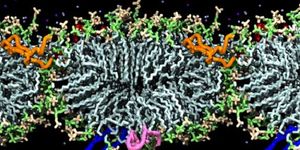What are those ghostly images? NASA's Hubble Space Telescope recently photographed a set of green objects that are floating outside our galaxy and are actually the wispy remains of quasars that flickered to life and then faded.

The glowing objects vary in structure with loops, helical, and braided shapes. "They don't fit a single pattern," said Bill Keel of the University of Alabama, Tuscaloosa, who initiated the Hubble survey. Keel believes the features offer insights into the less understood parts galaxies with energetic cores.
These filmy celestial bodies outside the host galaxy might have been illuminated by powerful ultraviolet radiation from a supermassive black hole at the core of host galaxy that is produced by superheated gases.
"However, the quasars are not bright enough now to account for what we're seeing; this is a record of something that happened in the past," Keel said.
One possible explanation is that pairs of co-orbiting black holes are powering the quasars, and this could change their brightness.
A process called photoionization is responsible for the beam illuminating these filaments. Oxygen atoms in the filaments absorb light from the quasar and slowly re-emit it over many thousands of years.
The green filaments are believed to be long tails of gas that get pulled apart by a merger of two galaxies. Rather than being blasted out of the quasar's black hole, these immense structures, tens of thousands of light-years long, are slowly orbiting their host galaxy long after the merger was completed.
"We see these twisting dust lanes connecting to the gas, and there's a mathematical model for how that material wraps around in the galaxy," Keel said. Potentially, you can say we're seeing it 1.5 billion years after a smaller gas-rich galaxy fell into a bigger galaxy."
Because they are so far outside of their host galaxy, they likely wouldn't light up until tens of thousands of years after the quasar outburst. It would also take that long for them to fade, since that is how long the light takes to reach them
Dutch schoolteacher Hanny van Arkel found the first "green goblin" type of object in 2007. She discovered the ghostly structure in the online Galaxy Zoo project. The project has enlisted the public to help classify more than a million galaxies catalogued in the Sloan Digital Sky Survey (SDSS), and moved on to add galaxies seen in Hubble images probing the distant universe. The bizarre feature was dubbed Hanny's Voorwerp, Dutch for Hanny's object.
Because his follow-up Hubble images of Hanny's Voorwerp were so intriguing, Keel started a deliberate hunt for more bizarre objects like it. They would share the rare and striking color signature of Hanny's Voorwerp on the SDSS images.
Under Keel's direction, 200 people volunteered to look at over 15,000 galaxies hosting quasars. Each candidate had to have at least 10 views that collectively revealed odd-colored clouds.
Keel's team took the galaxies that looked the most promising and further studied them by dividing their light into its component colors through a process called spectroscopy. In follow-up observations from Kitt Peak National Observatory and the Lick Observatory, his team found 20 galaxies that had gas that was ionized by radiation from a quasar, rather than from the energy of star formation.
Eight of the newly discovered clouds were more energetic than would be expected given the amount of radiation coming from the host quasar, even when observed in infrared light by NASA's Wide-field Infrared Survey Explorer (WISE) space telescope.
Keel speculated that this quasar variability might be explained if there are two massive black holes circling each other in the host galaxy's center, which might happen after two galaxies merged. Two black holes that were spinning near each other might disrupt the flow of gas falling into their centers. This would cause abrupt spikes in the accretion rate and trigger blasts of radiation.









